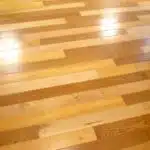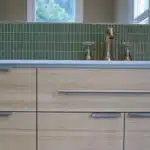When it comes to flooring options, hardwood has always been a popular choice among homeowners. Its durability, beauty and versatility add value to any home. However, with so many options available in the market today, choosing the right hardwood flooring can be a daunting task. Laminate and solid hardwood flooring are two of the most commonly used flooring materials today. While both have their own unique advantages and disadvantages, it is important to understand their differences before making a decision on which one to choose.
Laminate flooring is made from a high-density fiberboard core that is topped with an image of real wood. It is then sealed with a clear protective layer that makes it highly resistant to scratches and spills. On the other hand, solid hardwood flooring is made entirely from natural wood and comes in various species, colors and grades. Each type of hardwood has its own unique characteristics that make it suitable for different applications. In this article, we will explore the pros and cons of laminate vs solid hardwood flooring to help you make an informed decision about which one is best suited for your needs.
Understanding Your Flooring Options
As a flooring expert, it is important to understand the various options available in the market. Laminate and solid hardwood flooring are two popular choices, each with their own advantages and disadvantages. Laminate flooring is a type of synthetic flooring that is made up of several layers. It typically has a high-density fiberboard core with a photographic layer on top, which mimics the appearance of wood or other materials. There are different types of laminate flooring available, including glueless laminate, pre-glued laminate, and glued laminate.
On the other hand, engineered hardwood flooring is made up of several layers of wood veneer that are glued together to create a strong and stable floorboard. This type of flooring is more expensive than laminate but less expensive than solid hardwood. Engineered hardwood floors have a top layer of real wood that can be sanded and refinished over time. When comparing engineered hardwood to laminate, it’s important to note that engineered hardwood has a more natural look since it’s made from real wood.
When deciding between these two options, it ultimately comes down to personal preference and budget. Laminate flooring tends to be more cost-effective and easier to install than solid hardwood or engineered hardwood floors. Additionally, laminate floors are resistant to scratches, stains, and fading. In the subsequent section, we’ll explore the advantages of laminate flooring in more detail while also addressing any potential drawbacks homeowners should consider when selecting their next floor covering option.
The Advantages Of Laminate Flooring
Laminate flooring has become increasingly popular in recent years due to its many advantages over other types of flooring. One of the main benefits of laminate flooring is its cost-effectiveness. Laminate flooring is significantly cheaper than solid hardwood flooring, making it an excellent choice for those on a budget.
Another advantage of laminate flooring is its easy installation process. Unlike solid hardwood flooring, which requires professional installation and can take several days to complete, laminate flooring can be installed quickly and easily by anyone with basic DIY skills. This not only saves time but also money as you won’t have to pay for professional installation services.
Lastly, laminate flooring is incredibly durable and resistant to scratches, dents, and stains. It is made using a multi-layered synthetic material that mimics the look and feel of real wood while being more resilient to daily wear and tear. This makes it an excellent choice for high-traffic areas such as kitchens and living rooms.
- Laminate flooring is available in a wide range of styles and designs.
- It’s easy to clean and maintain, requiring only regular sweeping or vacuuming.
- Laminate flooring is environmentally friendly as it uses less natural resources than solid hardwood.
In contrast to the benefits of laminate flooring, solid hardwood offers some unique advantages that cannot be found in laminates.
The Benefits Of Solid Hardwood Flooring
As the old adage goes, “you get what you pay for,” and this is particularly true when it comes to hardwood flooring. While laminate flooring may be less expensive upfront, solid hardwood flooring offers numerous benefits that make it a worthwhile investment in the long run.
One of the most significant advantages of solid hardwood flooring is its sustainability. Hardwood floors are made from natural materials, which means they can be renewed and replenished over time. In contrast, laminate flooring is made from synthetic materials that are not biodegradable and can take years to decompose. Choosing solid hardwood flooring is an environmentally conscious decision that can contribute to a healthier planet.
Another benefit of solid hardwood flooring is its customization options. Hardwood floors come in a variety of species, colors, and finishes, allowing homeowners to create a unique look that complements their decor. Additionally, hardwood floors can be refinished multiple times throughout their lifespan, making it possible to change the color or finish without having to replace the entire floor.
When considering the benefits of solid hardwood flooring, durability and longevity are also critical factors. In the next section, we will explore how these attributes make hardwood floors an excellent investment for homeowners who want a reliable and long-lasting option for their home’s interior design.
Durability And Longevity
Durability is an important factor to consider when choosing between laminate and solid hardwood flooring, as it determines the flooring’s ability to withstand wear and tear over time. Longevity is a related factor, and is largely determined by the maintenance required for the flooring as well as the finishing used. Moisture, stain resistance, and scuffs are also important considerations for both laminate and hardwood flooring, as these can affect the overall look and lifespan of the flooring. Rotting, expansion, and installation are important factors to consider in terms of longevity, as these can affect the flooring’s performance and the cost of installation. Finally, warranties and resale value should also be taken into account when making a decision, as they can affect the flooring’s lifespan and cost.
Durability
When choosing a flooring option, durability is a critical factor to consider. Both laminate and solid hardwood flooring have their advantages and disadvantages in terms of scratch resistance, wear and tear, moisture resistance, and impact resistance.
Laminate flooring is known for its scratch-resistant properties due to its wear layer that protects the design layer underneath. However, as time goes on, this protective layer can become less effective, leading to visible scratches and dents. Additionally, laminate floors are more susceptible to water damage than solid hardwood floors. If exposed to excess moisture or standing water, the planks can warp and buckle. On the other hand, solid hardwood floors are generally more durable than laminate floors in terms of wear and tear. They can be sanded down and refinished multiple times over their lifespan to remove any scratches or dents.
When it comes to impact resistance, both laminate and solid hardwood flooring have their strengths and weaknesses. Laminate is generally more impact-resistant than solid hardwood because of its layered structure which allows it to absorb shock better. However, if the surface of the laminate floor is damaged by a heavy object or dropped tool, it may need to be replaced entirely. Solid hardwood has less give than laminate when subjected to impacts but can withstand heavy foot traffic without showing signs of wear as easily as laminates.
In conclusion, while both options have their pros and cons regarding durability concerns such as scratch resistance or moisture/impact resistance; there is no clear winner between laminate vs. solid hardwood flooring in terms of overall longevity as each type has unique characteristics that suit different needs depending on individual preferences or specific situations such as high traffic areas or exposure to moisture levels that could cause damage over time.
Longevity
When it comes to flooring options, consumers are often concerned about the cost effectiveness and environmental impact of their choices. In terms of durability and longevity, laminate and solid hardwood flooring have their own unique advantages and disadvantages. However, it is important to note that the lifespan of a floor is not just determined by its physical properties but also by its maintenance requirements and warranty options.
Laminate flooring is generally considered more cost-effective than solid hardwood due to its lower price point. While laminate floors can last for many years with proper care, they are not as durable as solid hardwood in terms of wear and tear. Laminate floors may need to be replaced sooner than solid hardwood if they become damaged or outdated in appearance. Additionally, the environmental impact of laminate flooring is a concern for those who prioritize eco-friendliness in their home design choices.
Solid hardwood floors are known for their longevity and ability to withstand heavy foot traffic without showing signs of wear as easily as laminates. While initially more expensive than laminate, solid hardwood can be sanded down and refinished multiple times over its lifespan, making it a sound investment for homeowners who value long-term durability. It is also worth noting that some manufacturers offer warranties on their solid hardwood products that can provide additional peace of mind for buyers.
Ultimately, when considering the longevity of a flooring option, it is important to take into account both the physical properties of the material as well as maintenance requirements and warranty options. By doing so, consumers can make informed decisions about which type of flooring will best suit their needs while providing optimal durability and longevity for their home.
Wear And Tear
When it comes to choosing a flooring option, one of the most important factors to consider is durability and longevity. However, wear and tear is a natural occurrence that can affect any type of flooring material over time. This can be caused by heavy foot traffic, furniture movement, and accidental spills or scratches. As such, it is essential to choose a flooring option that not only offers scratch resistance but also has repair options available.
For consumers who prioritize scratch resistance in their flooring options, laminate and engineered hardwood are popular choices. Laminate floors have a wear layer that protects against scratches and stains, making them ideal for high-traffic areas such as living rooms or hallways. Engineered hardwood also has a protective layer that makes it more resistant to scratches than traditional solid hardwood. However, both of these options may require replacement if they become too damaged over time.
On the other hand, solid hardwood floors have the advantage of being able to be sanded down and refinished multiple times over their lifespan. This means that even if there is significant wear and tear on the surface of the floor, it can be restored to its original condition with proper maintenance. Additionally, some manufacturers offer repair kits for minor scratches or dents in solid hardwood floors. By considering both scratch resistance and repair options when choosing a flooring material, consumers can ensure optimal durability and longevity for their home’s floors.
Maintenance And Care
As a flooring expert, it is essential to understand that laminate and solid hardwood floors require different maintenance and care. While both options are durable, they differ in how they react to moisture and wear over time. To keep your floors looking their best, regular cleaning is necessary, but preventative measures can also help extend the life of your flooring.
Regular cleaning is paramount for maintaining the appearance and longevity of your floors. For laminate, it is recommended to clean regularly with a microfiber mop or cloth and a gentle cleaner specifically designed for laminate flooring. Avoid using harsh chemicals or excessive amounts of water as this can cause damage over time. For solid hardwood floors, vacuuming or sweeping regularly with a soft-bristled brush attachment is best. It’s important to avoid using steam mops or excessive water, which can lead to swelling and cupping.
In addition to regular cleaning, preventative measures such as using area rugs or doormats can help protect your flooring from scratches and wear. For laminate flooring, it’s essential to use protective pads under furniture legs to prevent scratches or dents. Solid hardwood requires protective pads too but be sure to check them regularly for wear and replace them when needed. With proper care and preventative measures in place, you can enjoy your beautiful floors for years to come.
Transitioning into the next section on cost and affordability, it’s important to note that while both laminate and solid hardwood offer durability and beauty, they differ in price point.
Cost And Affordability
When it comes to cost and affordability, laminate flooring is the clear winner. Comparing prices between laminate and solid hardwood can show a significant difference in cost per square foot. Laminate flooring is an excellent budget-friendly option for those who want the look of hardwood without breaking the bank.
One reason laminate flooring is more affordable than solid hardwood is due to its manufacturing process. Laminate flooring is made from composite wood pressed together at high temperatures, while solid hardwood is cut from trees and requires more labor-intensive production. Additionally, laminate flooring can be installed quickly, reducing installation costs.
Another factor to consider when comparing prices is maintenance costs. Solid hardwood requires regular refinishing, which can add up over time. Laminate flooring, on the other hand, does not require refinishing and only needs occasional cleaning with a damp mop or vacuum.
Overall, if you’re looking for an affordable option that still provides the look of hardwood, laminate flooring is the way to go. Its lower cost per square foot and reduced maintenance costs make it an ideal choice for those on a budget.
As important as cost may be when making a decision about your home’s flooring, appearance and aesthetics are also crucial factors to consider. With that in mind, let’s explore how laminate and solid hardwood compare in terms of their visual appeal.
Appearance And Aesthetics
When it comes to appearance and aesthetics, both laminate and solid hardwood flooring have their advantages. Design versatility is a key consideration for homeowners when choosing between the two. Laminate floors are known for their ability to mimic the look of natural materials like wood or stone, while providing a more affordable and low-maintenance option. On the other hand, solid hardwood floors offer a timeless elegance that can enhance the overall aesthetic appeal of any room.
Color options are another important factor in determining which type of flooring to choose. Laminate floors come in a wide range of colors and patterns, making them an ideal choice for those who want to experiment with different styles without breaking the bank. Solid hardwood floors, on the other hand, offer a more limited selection of colors but provide a warm and natural feel that cannot be replicated by other types of flooring.
Ultimately, whether you choose laminate or solid hardwood flooring will depend on your personal preferences and budget. Both types of flooring offer unique benefits that can improve the look and feel of your home. When it comes to design versatility and color options, laminate floors may be your best bet if you’re looking for something versatile and affordable. However, if you’re willing to invest in the timeless elegance of solid hardwood floors, then they may be worth considering as well.
Transitioning into the next section about installation process, it’s important to understand that both laminate and solid hardwood flooring require different installation methods.
Installation Process
When it comes to installing laminate or solid hardwood flooring, there are two options: DIY or professional installation. While both options have their advantages, the choice ultimately depends on one’s skill level and time availability. DIY installation may save money, but it requires a significant amount of time and effort. It involves measuring the space, cutting the planks to size, and properly laying them down without leaving gaps or unevenness.
Professional installation, on the other hand, guarantees a flawless finish without any hassle. A flooring expert can complete the job much faster than an inexperienced homeowner, as they have the necessary tools and skills to handle any obstacles that may arise during installation. However, this option can be more expensive than DIY since it includes labor costs.
Another factor to consider is the time required for installation. Laminate flooring is typically quicker and easier to install than solid hardwood due to its click-and-lock system that doesn’t require nails or glue. On average, laminate flooring takes about 1-2 days to install in a standard-sized room. Solid hardwood flooring takes longer since each plank must be individually nailed down and glued together. The process can take up to 5 days depending on the size of the room.
Moving forward with environmental impact in mind…
Environmental Impact
Environmental Impact:
When it comes to choosing between laminate and solid hardwood flooring, the environmental impact of each should be considered. Sustainable sourcing is an important factor to take into account when making your decision. Solid hardwood flooring is often sourced from forests that are managed sustainably, meaning trees are replanted after being harvested. On the other hand, laminate flooring is typically made from synthetic materials that may not be sustainable.
Another aspect to consider is carbon footprint reduction. Solid hardwood flooring requires transportation from the source forest to the manufacturer and then again to the retailer or installer. This transportation can contribute to a larger carbon footprint compared to laminate flooring which can be manufactured locally and requires less transportation.
However, some laminate manufacturers are now offering environmentally friendly options such as recycled wood fibers for their core layer and low-VOC adhesives for installation. It is important to research specific brands and options if you are looking for a more sustainable choice.
- Sustainable sourcing should be a priority when selecting a floor type.
- Carbon footprint reduction should also be taken into consideration.
- Choosing solid hardwoods from sustainably managed forests can reduce deforestation.
- Locally manufactured laminates can have lower carbon footprints than imported hardwoods.
- Environmentally friendly options exist for both types of flooring.
With sustainability in mind, it’s important to weigh all factors before making a decision on which type of flooring is right for your space. While there are pros and cons to both laminate and solid hardwood, knowing how they impact the environment can help guide your choice. In the next section, we will explore another factor to consider when choosing between these two types of flooring: noise reduction.
Noise Reduction
Flooring soundproofing is an essential aspect to consider when choosing between laminate and solid hardwood flooring. Both types of flooring can produce noise, which can be disturbing to the occupants of the space. However, there are several acoustics solutions that can help reduce the noise level.
One option for reducing noise in laminate and solid hardwood flooring is to install sound-absorbing underlayments. These underlayments help to absorb the impact of footsteps and other sounds, reducing noise transmission from one floor to another. Additionally, area rugs or carpets can also be used as a sound absorption solution.
Another way to reduce noise in laminate and solid hardwood flooring is by filling gaps between planks or boards with acoustic sealant. This helps prevent sound from traveling through small gaps that may exist between planks or boards. The use of acoustic sealant can also improve energy efficiency by reducing drafts and air leaks.
Overall, it is important to address flooring soundproofing when considering either laminate or solid hardwood flooring. By utilizing acoustics solutions such as sound-absorbing underlayments and acoustic sealant, homeowners can greatly reduce the amount of noise produced by their floors. In the next section, we will discuss how these types of flooring impact resale value.
Resale Value
As a flooring expert, I often use the allegory of a house as a metaphor for the human body. Just as the foundation is essential to the stability and longevity of a home, so too is flooring to the comfort and value of our living spaces. In this section, we will compare the resale value of laminate versus solid hardwood flooring and explore how this important aspect is affected by flooring choice.
When it comes to resale value, both laminate and solid hardwood have their pros and cons. Here are four factors that can affect how much your flooring choice impacts your home’s resale value:
- The quality of installation – Proper installation is crucial for both types of flooring. A poorly installed laminate or hardwood floor can detract from your home’s value.
- The type of wood used – If you choose solid hardwood, it’s important to note that some woods are more valuable than others.
- The age and condition of the floors – Over time, even the most durable floors will show signs of wear and tear.
- Local market conditions – The resale value of your home will be influenced by local real estate trends.
Ultimately, which type of flooring you choose should depend on your personal preference, budget, and lifestyle needs. However, it’s clear that both laminate and solid hardwood can add significant value to your home when chosen wisely.
When considering resale value alone, solid hardwood may have a slight edge over laminate due to its reputation for durability and luxury appeal. However, it’s important to consider other factors such as maintenance requirements and cost when making a final decision about which type of flooring is right for you. In the next section, we will dive deeper into another critical aspect: comfort and feel underfoot.
Comfort And Feel Underfoot
When it comes to comfort and feel underfoot, laminate and solid hardwood flooring offer different experiences. Softness vs. hardness is a crucial factor in this regard. Solid hardwood is known for its warmth, softness, and comfort underfoot, which can be attributed to its natural wood composition. Laminate flooring, on the other hand, is made of multiple layers of synthetic materials that do not offer the same level of softness as solid hardwood.
Texture vs. smoothness is another aspect to consider when comparing laminate and solid hardwood flooring options. Solid hardwood floors have an unmistakable texture that adds depth and character to any room. The grain patterns and knots create a unique look that cannot be replicated by any other type of flooring material. By contrast, laminate floors tend to have a uniform appearance with little variation in texture or pattern.
When choosing between laminate and solid hardwood floors for your home or business, it’s essential to consider all aspects of the experience underfoot. If you’re seeking warmth, softness, and character in your flooring choice, solid hardwood might be the better option for you. However, if you prefer a smooth surface with a uniform appearance that’s easy to clean and maintain, laminate could be the way to go.
Looking ahead at our subsequent section about pet-friendliness, it’s worth noting that there are additional factors beyond comfort underfoot that can impact your decision-making process when selecting new flooring for your home or business.
Pet-Friendliness
The paw prints of your furry friend can leave a lasting impression on your flooring. When it comes to pet-friendly flooring options, both laminate and solid hardwood have their pros and cons. Laminate flooring is more resistant to scratches and stains than solid hardwood, making it an ideal choice for pet owners who want a low-maintenance floor. However, laminate does not have the same luxurious feel as solid hardwood and can be noisy underfoot.
Solid hardwood flooring is a timeless classic that adds value and warmth to any home. However, it can be easily scratched by pets, causing unsightly marks on the surface. To deal with scratches, consider choosing a harder wood species or opting for distressed or hand-scraped finishes that hide imperfections better. Another option is to use area rugs or runners in high-traffic areas to protect the floor from scratches.
In summary, both laminate and solid hardwood have their advantages and disadvantages when it comes to pet-friendly flooring options. It ultimately depends on your personal preference and lifestyle needs. If you prioritize low maintenance and durability over luxury, then laminate may be the way to go. If you prefer the aesthetic appeal of natural wood and are willing to take extra care of your floors, then solid hardwood may be worth considering for your furry companions. Moving forward, we will discuss how allergies and health concerns play a role in choosing between these two popular flooring options.
Allergies And Health Concerns
For those with allergies or chemical sensitivity concerns, laminate flooring may be the better choice. Many laminate options are available that are hypoallergenic, meaning they do not contain materials that commonly cause allergic reactions or irritations. In contrast, solid hardwood flooring can contain natural oils and resins that can trigger allergy symptoms in some people.
However, it is important to note that not all laminate flooring options are created equal. Some may still contain chemicals or materials that could cause issues for those with sensitivities. It is important to thoroughly research and read labels before making a decision.
If you have concerns about allergies or chemical sensitivities, it may be best to consult with a flooring professional who can help guide you towards the best options for your specific needs. They can also provide information on proper installation techniques and maintenance to ensure the longevity of the flooring and minimize any potential negative effects on your health.
Ultimately, it is crucial to make an informed decision when choosing between laminate and solid hardwood flooring. By considering factors such as allergies and chemical sensitivity concerns, you can make a choice that not only looks beautiful in your home but also promotes a healthy living environment.
Making The Right Choice For Your Home
Are you tired of hearing the age-old debate between laminate and solid hardwood flooring? The truth is, both options have their pros and cons. However, the decision ultimately boils down to your personal style preferences and flooring budget.
Let’s start with laminate flooring. This type of flooring has come a long way in recent years and can mimic the look of hardwood at a fraction of the cost. It is also incredibly durable and resistant to scratches, making it a great option for high-traffic areas. On the downside, laminate cannot be refinished like solid hardwood and may need to be replaced entirely if damaged.
On the other hand, solid hardwood flooring exudes elegance and adds value to any home. It can also be refinished multiple times over its lifespan, allowing you to change up the color or finish as often as you’d like. However, it tends to be more expensive than laminate and requires regular maintenance to prevent scratches and water damage.
To help you make an informed decision, take a look at this table outlining some key differences between laminate and solid hardwood flooring:
| Laminate Flooring | Solid Hardwood Flooring | |
|---|---|---|
| Cost | Less expensive | More expensive |
| Maintenance | Easy to clean; resistant to scratches | Requires regular maintenance (sanding/refinishing) |
| Durability | Resistant to scratches; cannot be refinished | Can be refinished multiple times; susceptible to scratches/damage from water |
Ultimately, whether you choose laminate or solid hardwood flooring depends on your personal style preferences and budget. If you’re looking for an affordable option that’s easy to maintain but still looks great, go with laminate. However, if you’re willing to invest in timeless elegance that will last for decades with proper care, solid hardwood is the way to go.
Conclusion
When it comes to choosing between laminate and solid hardwood flooring, there are several factors to consider. Laminate flooring is a cost-effective and low-maintenance option that offers a wide range of styles and colors to choose from. It is also durable and resistant to scratches, stains, and fading. However, it may not have the same authentic look and feel as solid hardwood flooring.
On the other hand, solid hardwood flooring is a classic choice that adds warmth, elegance, and value to any home. It has a natural beauty that cannot be replicated by laminate flooring or other synthetic materials. It is also more durable than many people think, especially when properly maintained. However, it requires more care and attention than laminate flooring and can be more expensive upfront.
For example, let’s say you have a family with young children who love to play on the floor. They often spill drinks or drop toys on the ground. In this case, laminate flooring may be a better choice because it is less likely to get damaged by spills or impacts. It is also easier to clean up messes quickly without leaving stains or water damage behind.
In conclusion, both laminate and solid hardwood flooring have their advantages and disadvantages depending on your specific needs and preferences. As a flooring expert, I recommend considering factors such as durability, maintenance requirements, comfort underfoot, pet-friendliness, allergies, health concerns, style options, and budget when making your decision. By doing your research and consulting with professionals in the industry like myself you will ensure that you make an informed decision that best suits your lifestyle needs while adding value for years to come!
Image Credits
- “Early morning at the house in Lamine after our overnight stay” by PiktourUK (featured)





























